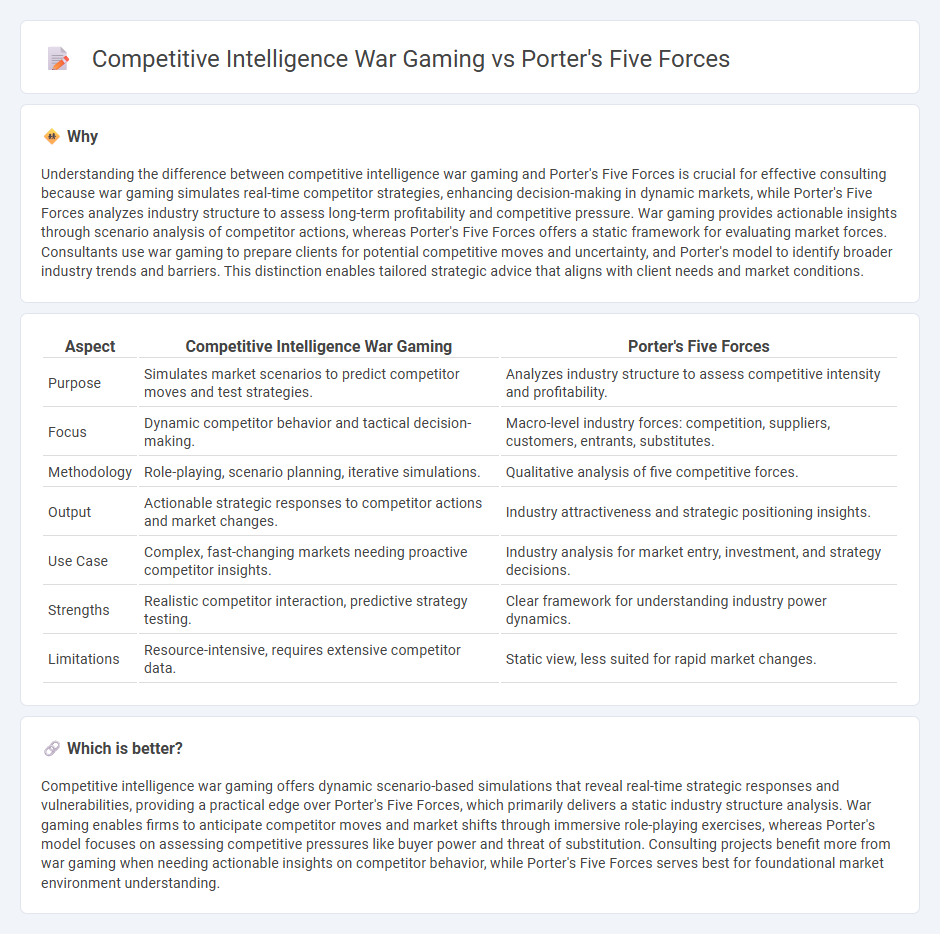
Competitive intelligence war gaming simulates real-world market scenarios to anticipate competitor strategies and responses, enhancing strategic decision-making. Porter's Five Forces offers a structured framework to analyze industry attractiveness by examining competitive rivalry, supplier power, buyer power, threat of substitutes, and barriers to entry. Discover how integrating these methodologies can elevate your business competitiveness.
Why it is important
Understanding the difference between competitive intelligence war gaming and Porter's Five Forces is crucial for effective consulting because war gaming simulates real-time competitor strategies, enhancing decision-making in dynamic markets, while Porter's Five Forces analyzes industry structure to assess long-term profitability and competitive pressure. War gaming provides actionable insights through scenario analysis of competitor actions, whereas Porter's Five Forces offers a static framework for evaluating market forces. Consultants use war gaming to prepare clients for potential competitive moves and uncertainty, and Porter's model to identify broader industry trends and barriers. This distinction enables tailored strategic advice that aligns with client needs and market conditions.
Comparison Table
| Aspect | Competitive Intelligence War Gaming | Porter's Five Forces |
|---|---|---|
| Purpose | Simulates market scenarios to predict competitor moves and test strategies. | Analyzes industry structure to assess competitive intensity and profitability. |
| Focus | Dynamic competitor behavior and tactical decision-making. | Macro-level industry forces: competition, suppliers, customers, entrants, substitutes. |
| Methodology | Role-playing, scenario planning, iterative simulations. | Qualitative analysis of five competitive forces. |
| Output | Actionable strategic responses to competitor actions and market changes. | Industry attractiveness and strategic positioning insights. |
| Use Case | Complex, fast-changing markets needing proactive competitor insights. | Industry analysis for market entry, investment, and strategy decisions. |
| Strengths | Realistic competitor interaction, predictive strategy testing. | Clear framework for understanding industry power dynamics. |
| Limitations | Resource-intensive, requires extensive competitor data. | Static view, less suited for rapid market changes. |
Which is better?
Competitive intelligence war gaming offers dynamic scenario-based simulations that reveal real-time strategic responses and vulnerabilities, providing a practical edge over Porter's Five Forces, which primarily delivers a static industry structure analysis. War gaming enables firms to anticipate competitor moves and market shifts through immersive role-playing exercises, whereas Porter's model focuses on assessing competitive pressures like buyer power and threat of substitution. Consulting projects benefit more from war gaming when needing actionable insights on competitor behavior, while Porter's Five Forces serves best for foundational market environment understanding.
Connection
Competitive intelligence war gaming leverages Porter's Five Forces to simulate market scenarios by analyzing industry rivalry, supplier power, buyer power, threat of substitutes, and barriers to entry. This strategic exercise helps consultants anticipate competitor actions and market shifts, enhancing decision-making accuracy. Integrating Porter's framework into war gaming sharpens insights into competitive dynamics and external pressures critical for advisory services.
Key Terms
Industry Structure
Porter's Five Forces analyzes industry structure by evaluating the competitive intensity through supplier power, buyer power, threat of new entrants, threat of substitutes, and industry rivalry. Competitive intelligence war gaming simulates real-time strategic scenarios to anticipate competitor actions and market reactions within that same industry framework. Discover how integrating these approaches can enhance your strategic decision-making.
Scenario Analysis
Porter's Five Forces framework systematically evaluates industry competitiveness through the analysis of supplier power, buyer power, competitive rivalry, threat of substitution, and new entrants. Competitive intelligence war gaming incorporates scenario analysis to simulate strategic responses under varying market conditions, enhancing predictive accuracy beyond traditional static models. Explore how integrating these methodologies can refine strategic decision-making by visiting our detailed analysis.
Competitive Dynamics
Porter's Five Forces framework analyzes competitive dynamics by evaluating industry rivalry, supplier power, buyer power, threat of substitutes, and barriers to entry, providing a comprehensive industry structure perspective. Competitive intelligence war gaming simulates competitor behaviors and strategic responses in dynamic market scenarios, offering real-time insights into potential moves and countermoves among rivals. Explore the strategic advantages of integrating both methods to enhance your competitive dynamics understanding.
Source and External Links
Porter's five forces analysis - Wikipedia - Porter's Five Forces Framework, created by Michael E. Porter, analyzes the competitive environment through five forces that determine industry profitability and competitive intensity, helping businesses understand their market context and profitability potential.
Porter's 5 Forces Framework: Explanation & Uses - Quantive - This framework helps evaluate industry attractiveness and competitive intensity, enabling strategic responses such as strengthening barriers to entry, managing supplier and buyer power, and mitigating threats from substitutes to maintain competitive advantage.
Porter's Five Forces: The Ultimate Competitive Strategy Blueprint | TSI - Porter's Five Forces helps companies understand five key competitive forces shaping long-term profitability, guiding strategy formulation to identify opportunities and threats and establish resilient market positions.
 dowidth.com
dowidth.com